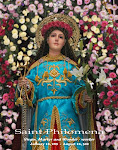Praised be Jesus, Mary,
and Joseph!
For
forty days, Jesus appeared to his Apostles and spoke about the Kingdom of God.
After he had spoken to them, Jesus was taken into heaven, and took his seat at
the right hand of God “far above every principality, authority, power, and
dominion…” The Acts of the Apostles said: “a cloud took him from their sight.”
Taking his seat at God’s right hand and having disappeared amongst the clouds,
Jesus might seem to have left his Apostles behind. But this is not so. He may
have disappeared but he did not leave. While he is enthroned far above every
principality, authority, power, and dominion, the Lord Jesus nevertheless
remains present in the world. He may have disappeared physically but this does
not mean he is no longer here. The manner of his presence merely changed for
Christ continues to be present in the world through his Church.
Before
he ascended into heaven, he spoke of signs that will accompany his followers,
that is, those who believe: “in my name, they will drive out demons…They will
lay their hands on the sick, and they will recover.” Come to think of it, these
signs Jesus referred to were simply the things he had been doing while on
earth. By giving his disciples the power to do what he used to do while amongst
them, Jesus was actually saying that the Church will continue to do his work on
earth. The more precise statement would be: Jesus will continue doing what he
has always been doing – this time, he will do his works through the Church.
This is why St. Paul said that the Father, seating Jesus at his right hand in
the heavens, “put all things beneath his feet and gave his as head over all
things to the Church, which is his body, the fullness of the one who fills all
things in every way.”
The
Catechism says: “As Lord, Christ is also head of the Church, which is his Body.
Taken up to heaven and glorified after he had thus fully accomplished his
mission, Christ dwells on earth in his Church.” (CCC, 669) Also, the same
Catechism says elsewhere: “Christ ‘is the head of the body, the Church.’ He is
the principle of creation and redemption. Raised to the Father’s glory, ‘in
everything he is preeminent,’ especially in the Church, through whom he extends
his reign over all things.” (CCC, 792) “Christ and his Church thus together
make up the ‘whole Christ’ (Christus
totus). The Church is one with Christ.” (CCC, 795) Thus, St. Augustine
exclaims: “Let us rejoice, then, and give thanks that we have become not only
Christians, but Christ himself. Do you understand and grasp, brethren, God’s
grace towards us? Marvel and rejoice: we have become Christ. For if he is the
head, we are the members; he and we together are the whole man…The fullness of
Christ then is the head and the members. But what does ‘head and members’ mean?
(It means) Christ and the Church.” (Ibid.)
The Church is the Sacrament of Christ. She makes him visible. Her teachings
make him heard. Her presence makes him present. The common sense of St. Joan of
Arc says it in very clear terms: “About Jesus Christ and the Church, I simply
know they are just one thing, and we shouldn’t complicate the matter.” (Ibid.)
Jesus,
I trust in you. O Mary conceived without sin, pray for us who have recourse to
thee!










No comments:
Post a Comment